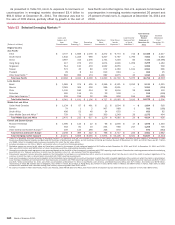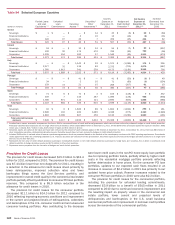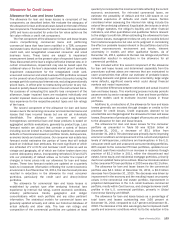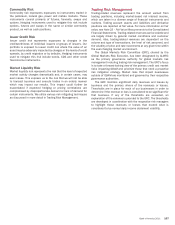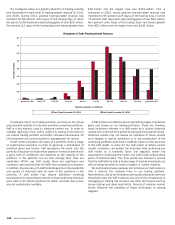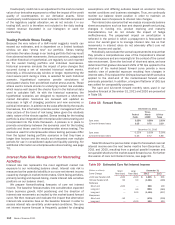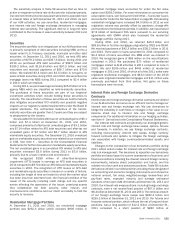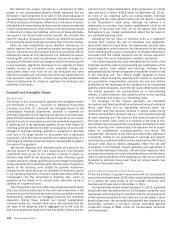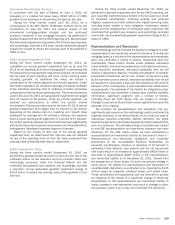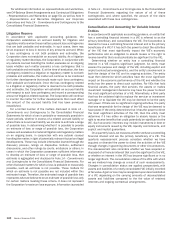Bank of America 2011 Annual Report Download - page 112
Download and view the complete annual report
Please find page 112 of the 2011 Bank of America annual report below. You can navigate through the pages in the report by either clicking on the pages listed below, or by using the keyword search tool below to find specific information within the annual report.
110 Bank of America 2011
Counterparty credit risk is an adjustment to the mark-to-market
value of our derivative exposures to reflect the impact of the credit
quality of counterparties on our derivative assets. Since
counterparty credit exposure is not included in the VaR component
of the regulatory capital allocation, we do not include it in our
trading VaR, and it is therefore not included in the daily trading-
related revenue illustrated in our histogram or used for
backtesting.
Trading Portfolio Stress Testing
Because the very nature of a VaR model suggests results can
exceed our estimates, and is dependent on a limited lookback
window, we also “stress test” our portfolio. Stress testing
estimates the value change in our trading portfolio that may result
from abnormal market movements. Various scenarios, categorized
as either historical or hypothetical, are regularly run and reported
for the overall trading portfolio and individual businesses.
Historical scenarios simulate the impact of price changes that
occurred during a set of extended historical market events.
Generally, a 10-business-day window or longer, representing the
most severe point during a crisis, is selected for each historical
scenario. Hypothetical scenarios provide simulations of
anticipated shocks from pre-defined market stress events. These
stress events include shocks to underlying market risk variables
which may be well beyond the shocks found in the historical data
used to calculate VaR. As with the historical scenarios, the
hypothetical scenarios are designed to represent a short-term
market disruption. Scenarios are reviewed and updated as
necessary in light of changing positions and new economic or
political information. In addition to the value afforded by the results
themselves, this information provides senior management with a
clear picture of the trend of risk being taken given the relatively
static nature of the shocks applied. Stress testing for the trading
portfolio is also integrated with enterprise-wide stress testing and
incorporated into the limits framework. A process is in place to
promote consistency between the scenarios used for the trading
portfolio and those used for enterprise-wide stress testing. The
scenarios used for enterprise-wide stress testing purposes differ
from the typical trading portfolio scenarios in that they have a
longer time horizon and the results are forecasted over multiple
periods for use in consolidated capital and liquidity planning. For
additional information on enterprise-wide stress testing, see page
70.
Interest Rate Risk Management for Nontrading
Activities
Interest rate risk represents the most significant market risk
exposure to our nontrading balance sheet. Interest rate risk is
measured as the potential volatility in our core net interest income
caused by changes in market interest rates. Client-facing activities,
primarily lending and deposit-taking, create interest rate sensitive
positions on our balance sheet.
We prepare forward-looking forecasts of core net interest
income. The baseline forecast takes into consideration expected
future business growth, ALM positioning and the direction of
interest rate movements as implied by the market-based forward
curve. We then measure and evaluate the impact that alternative
interest rate scenarios have on the baseline forecast in order to
assess interest rate sensitivity under varied conditions. The core
net interest income forecast is frequently updated for changing
assumptions and differing outlooks based on economic trends,
market conditions and business strategies. Thus, we continually
monitor our balance sheet position in order to maintain an
acceptable level of exposure to interest rate changes.
The interest rate scenarios that we analyze incorporate balance
sheet assumptions such as loan and deposit growth and pricing,
changes in funding mix, product repricing and maturity
characteristics, but do not include the impact of hedge
ineffectiveness. The prepayment impact on amortization is
reflected in the period in which a prepayment is forecasted to
occur. Our overall goal is to manage interest rate risk so that
movements in interest rates do not adversely affect core net
interest income and capital.
Periodically, we evaluate the scenarios presented to ensure that
they provide a comprehensive view of the Corporation’s interest
rate risk exposure and are meaningful in the context of the current
rate environment. Given the low level of short-end rates, we have
determined that gradual downward shifts of 50 bps applied to the
short-end of the market-based forward curve provide a more
realistic view of potential exposure resulting from changes in
interest rates. This replaced the 100 bps downward shift scenarios
applied to the short-end of the market-based forward curve
previously presented. In addition, a long-end flattener of (50) bps
was added for comparability purposes.
The spot and 12-month forward monthly rates used in our
baseline forecast at December 31, 2011 and 2010 are presented
in Table 58.
Table 58
Spot rates
12-month forward rates
Spot rates
12-month forward rates
Forward Rates
December 31, 2011
Federal
Funds
0.25%
0.25
December 31, 2010
0.25%
0.25
Three-
Month
LIBOR
0.58%
0.75
0.30%
0.72
10-Year
Swap
2.03%
2.29
3.39%
3.86
Table 59 shows the pre-tax dollar impact to forecasted core net
interest income over the next twelve months from December 31,
2011 and 2010, resulting from a gradual parallel increase and
non-parallel shocks to the market-based forward curve. For further
discussion of core net interest income, see page 33.
Table 59
(Dollars in millions)
Curve Change
+100 bps Parallel shift
-50 bps Parallel shift
Flatteners
Short end
Long end
Long end
Steepeners
Short end
Long end
Estimated Core Net Interest Income
Short
Rate (bps)
+100
-50
+100
—
—
–50
—
Long
Rate (bps)
+100
-50
—
-50
-100
—
+100
December 31
2011
$ 1,505
(1,061)
588
(581)
(1,199)
(478)
929
2010
$ 601
(499)
136
(280)
(637)
(209)
493


